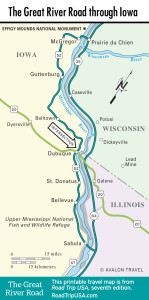Marquette to Guttenberg
Marquette & Effigy Mounds National Monument
Immediately across, and effectively underneath, the long bridges over the Mississippi from Prairie du Chien, Marquette (pop. 454) is a homey workaday community that verges on quaint. The main reason to visit is 3 mi (4.8 km) north of Marquette, right along the riverbank: the Effigy Mounds National Monument (563/873-3491, ext. 123, daily, free), which preserves 2,500 ac (1,012 ha) of natural riverside ecosystems plus more than 200 distinct burial mounds, many shaped like birds and animals, for example, the Great Bear Mound. The unusual mounds are traces of the people who lived along the Mississippi from around 500 BC to the time of first European contact. The visitors center has exhibits on the archaeology of the mounds, and 12 mi (19.3 km) of hiking trails reach from the river to restored vestiges of the native tallgrass prairie.
McGregor
Just south of Marquette, near the foot of the “original” Pike’s Peak—Zebulon Pike came up the Mississippi before he went out west to Colorado—McGregor (pop. 842) is a river town which has enticing old saloons and storefronts that are a fine reason to stop and stretch your legs, watch the boat and barge traffic, or simply wander along the water. A number of browsable antiques-and-collectibles shops line the GRR through the four-block main business district.
Just south of town, the 500-ft-high (152-m) limestone bluff known as Pike’s Peak is one of the highest points anywhere along the Mississippi River and has been protected at the center of spacious green Pike’s Peak State Park (563/873-2341), with hiking trails, scenic viewpoints, and a campground with a small store, hot showers, and RV hookups.
Guttenberg
Atop the bluffs, tidy frame farmhouses dot the landscape, with white barns, silos, and farmland aroma accompanying US-18 and US-52 as they loop inland south toward Guttenberg (pop. 1,811), another postcard-pretty old river town which has a downtown that lines the Mississippi. In fact, it’s one of the few Mississippi riverfronts where the river itself is not hidden away behind levees. A long, green riverside park, just a quick two blocks east of the main highway, makes the downtown area a particularly pleasant place to stroll.
Guttenberg is indeed named in honor of Johannes Gutenberg, 15th-century inventor of printing from moveable type. Local legend has it that an official of French descent purposely added the extra “t” after German residents won a vote to change the town’s name from the original Prairie la Porte. Germanic surnames still predominate in the local phone book, and the two main streets, which run perpendicular to the Mississippi, are named Schiller and Goethe.
On the north side of town, the GRR takes an up-close look at the prairie’s geological underpinnings as it cuts down to the river’s edge. From the downtown area, it’s a quick walk upriver to the concrete walls of Lock and Dam No. 10. Besides giving a sense of the massive engineering that attempts to tame the Mississippi, the locks are also one block south of an aquarium that offers a quick biology lesson through displays of live specimens of many of the river’s fish and invertebrate species.
There are great views to be had in the first few miles of Iowa’s GRR route south of Guttenberg. Just over 10 well-signed mi (16.1 km) south of Guttenberg, you can take the Cassville ferry across the Mississippi from Millville and visit the unique Dickeyville Grotto, or stay on the Iowa side and cruise through the Germanic eye-blink towns that dot the rolling uplands between Guttenberg and Dubuque. Midway along, tiny Balltown in particular is worth a stop to sample the huge portions and captivating decor at Breitbach’s (563 Balltown Rd., 563/552-2220), a bar and restaurant that’s so old President Millard Fillmore issued the permit allowing it to open.
Iowa Travel Map
















